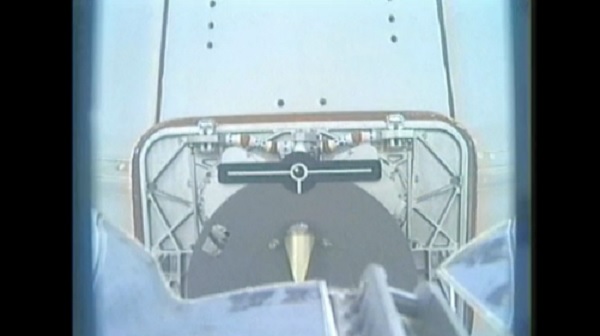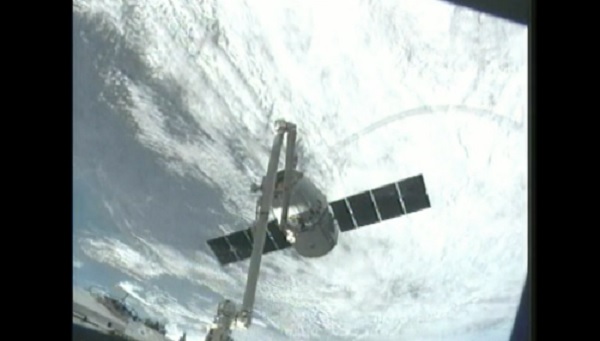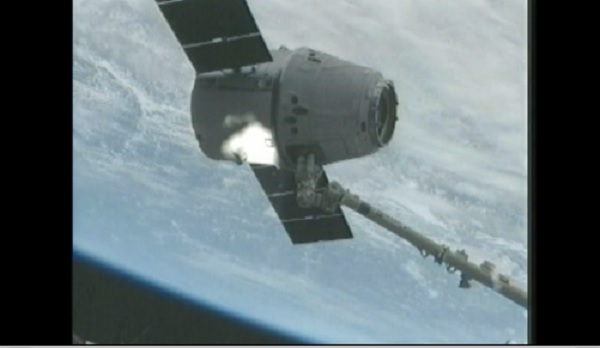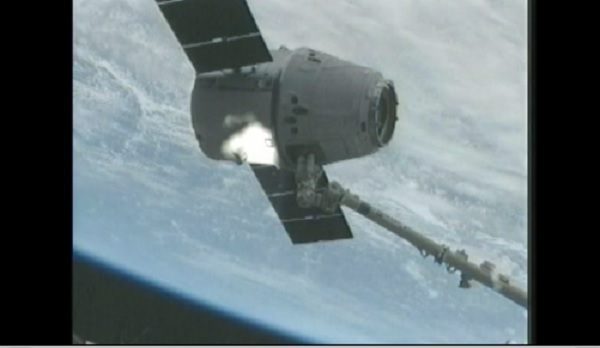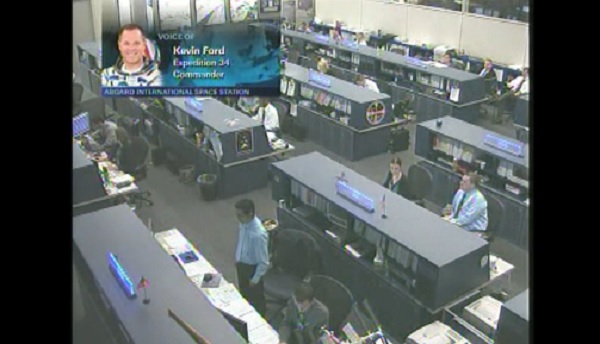.
SpaceX's Dragon capsule will attempt to berth at the International Space early Sunday, a day later than planned after overcoming thruster system issues.
Space station crew members Kevin Ford and Tom Marshburn plan to grapple the dragon with a 58-foot robotic arm at 6:01 a.m. EST.
If successful, the capsule will be pulled into a docking port on the station's Harmony node later in the morning.
Loaded with a ton of food, supplies, science experiments and hardware, the Dragon lifted off from Cape Canaveral Air Force Station atop a Falcon 9 rocket at 10:10 a.m. Friday.
After reaching orbit about 10 minutes later, SpaceX engineers discovered a blockage line or stuck valve in a pressurization was preventing three of the spacecraft's four thruster pods from being activated.
By late afternoon, the problem had been cleared up, but the Dragon had missed its chance to approach the station Saturday morning.
Today, ISS managers unanimously agreed that the Dragon's propulsion system is operating normally and the spacecraft and station are ready for the rendezvous.
If the berthing goes as planned, the Dragon would still be expected to depart the station March 25 despite arriving a day late.
Live NASA TV coverage of the Dragon's approach and capture begins at 3 a.m. Sunday, with berthing coverage to follow at 7:30 a.m.
The resupply mission is the second of 12 under a $1.6 billion NASA contract. Dragon capsules visited the station successfully twice last year, once under the contract and once on a demonstration flight.
Quelle: Florida Today
.
With its propulsion system working flawlessly, a SpaceX cargo ship loaded with supplies and equipment bound for the International Space Station was cleared by NASA Saturday to press ahead for a day-late capture by the lab complex early Sunday.
NASA space station managers and their SpaceX counterparts met Saturday to assess the Dragon capsule's performance following launch Friday and concluded all systems were "go" for a replanned rendezvous and capture by the station's robot arm Sunday at 6:31 a.m. EST (GMT-5).
"The station's Mission Management Team unanimously agreed that Dragon’s propulsion system is operating normally along with its other systems and ready to support the rendezvous," NASA said in a web update.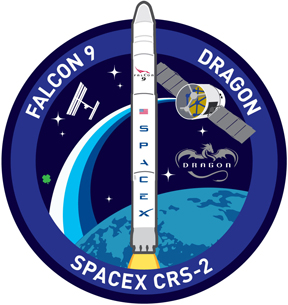
| SpaceX mission patch for the company's second operational space station resupply mission. (Credit: SpaceX) |
The original flight plan called for capture and berthing Saturday morning, but mission managers were forced to replan the approach after SpaceX flight controllers ran into problems with the capsule's maneuvering thrusters.
Just after the Dragon capsule separated from its Falcon 9 rocket Friday, telemetry showed that three of four sets of thrusters were off line due to problems pressurizing oxidizer propellant tanks. As a result, the spacecraft could not be properly oriented for normal communications and battery charging once its two solar arrays were deployed.
After reviewing telemetry, SpaceX flight controllers concluded the problem likely was the result of blockage in a pressurization line somewhere in the system. By cycling other valves and "pressure hammering" the lines, whatever was causing the problem eventually went away and all four oxidizer tanks were successfully pressurized.
A series of rocket firings verified the thrusters were healthy and commands were uplinked to carry out a critical maneuver to raise the low point of the Dragon's orbit.
Since then, the Dragon, flying six miles below the space station, passed ahead and looped up to a point well above the lab complex. At the higher altitude, the Dragon's velocity was slightly less than the station's, causing it to drop back behind the outpost.
Rocket firings later this evening were planned to drop the Dragon behind and below the station where it will start its final approach early Sunday.
"SpaceX officials reported to the multinational management team that all of Dragon's systems are operating as planned," NASA reported in its update. "SpaceX said it has high confidence there will be no repeat of the thruster problem during rendezvous, including its capability to perform an abort, should that be required."
If all goes well, the cargo ship will reach a point about 30 feet from the lab shortly after 6 a.m. At that point, Expedition 34 commander Kevin Ford, operating the station's robot arm from a robotics work station in the multi-window Cupola compartment, will lock on to a grapple fixture around 6:31 a.m. to complete the extended rendezvous.
During the first two dockings of Dragon capsules last May and October, the station crew manually operated the arm to maneuver the supply craft to berthing at the Earth-facing port of the forward Harmony module.
But this time around, ground controllers at the Johnson Space Center in Houston will take over, sending commands to remotely operate the arm through berthing to demonstrate their ability to carry out complex arm procedures and to give the astronauts a bit of a break during a very busy day.
The Dragon capsule is packed with some 2,300 pounds of equipment and provisions, including 178 pounds of crew supplies; 300 pounds of space station hardware, including replacement components for the lab's carbon dioxide removal system; and more than 700 pounds of science gear, including a pair of Glacier freezers and experiment components.
A spacewalk equipment handling fixture called a grapple bar is mounted in the Dragon capsule's unpressurized trunk section. The station's robot arm, again operated by flight controllers in Houston, will be used a few days after berthing to extract the grapple bar assembly and stow it on the station's exterior for future use.
After unloading the capsule, Ford and his crewmates will re-pack it with 1.5 tons of no-longer needed gear, components that need refurbishment or failure analysis and experiment samples that are needed by scientists back on Earth.
The return manifest includes 209 pounds of crew equipment; 1,455 pounds of science gear, including a Glacier freezer and cold bags loaded with experiment samples; and 884 pounds of space station hardware.
The Dragon will be detached from the station March 25, setting up a fiery re-entry and splashdown in the Pacific Ocean southwest of Los Angeles.
The SpaceX Dragon capsule is the only space station cargo craft designed to bring cargo back to Earth, a critical capability that was lost when NASA's space shuttle fleet was retired in 2011.
The manned Russian Soyuz spacecraft that carry three-person crews to and from the space station can only bring back a few hundred pounds of cargo. All other station vehicles -- unmanned Russian Progress supply ships and European and Japanese cargo craft -- burn up during re-entry.
Quelle: CBS
-
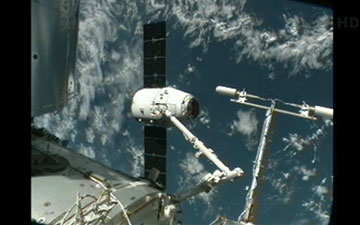
Dragon Berthing Process Under Way
Sun, 03 Mar 2013 01:03:22 PM GMT+0100
The International Space Station Expedition 34 crew successfully captured the SpaceX Dragon capsule with the station’s robotic arm at 5:31 a.m. EST. Dragon is scheduled to be berthed to space station at approximately 9:40 am EST.
Quelle: NASA
-
Dragon cargo ship captured by station arm
After recovering from thruster problems and flying a near-perfect rendezvous, a SpaceX cargo ship pulled up to the International Space Station early Sunday and stood by while commander Kevin Ford, wielding the lab's robot arm, locked onto a grapple fixture to secure the spacecraft for berthing.
Operating the Canadian-built arm from a robotics work station in the multi-window Cupola compartment, Ford grappled the Dragon cargo ship at 5:31 a.m. EST (GMT-5), an hour earlier than expected, as the two spacecraft passed 253 miles above northern Ukraine.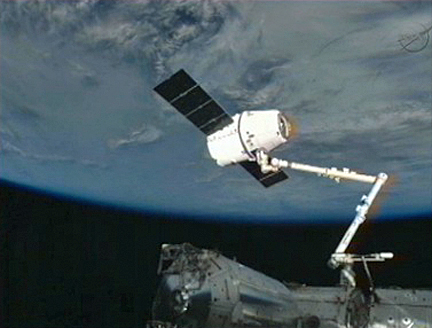
| After a flawless rendezvous, a SpaceX Dragon cargo capsule was captured by the International Space Station's robot arm early Sunday, bringing more than a ton of supplies and equipment to the outpost. (Credit: NASA TV) |
Flight controllers at the Johnson Space Center in Houston congratulated the crew for "a brilliant capture."
"Let me just say congratulations to the SpaceX and Dragon team in Houston and in California," Ford replied. "As they say, it's not where you start but where you finish that counts, and you guys really finished this one on the mark. You're aboard, and we've got a lot of science to bring aboard and get done."
Capture came a day later than originally planned because of problems pressurizing rocket thruster propellant tanks shortly after the ship reached orbit Friday.
But SpaceX flight controllers at company headquarters in Hawthorne, Calif., were able to coax the system into normal operation and while the root cause of the problem is not yet known, the thrusters worked normally throughout the replanned rendezvous.
Making the company's third space station visit -- the second fully operational flight under a $1.6 billion commercial contract with NASA -- the Dragon capsule is loaded with some 2,300 pounds of supplies, spare parts and science gear.
The manifest includes 178 pounds of crew provisions, including food and clothing; 300 pounds of space station hardware, including replacement components for the lab's carbon dioxide removal system; and more than 700 pounds of science gear, including a pair of Glacier freezers and experiment components.
During the first two dockings of Dragon capsules last May and October, the station crew attached the cargo ship to the station, manually operating the arm to maneuver the spacecraft to the Earth-facing port of the forward Harmony module.
But this time around, ground controllers at the Johnson Space Center in Houston planned to take over, sending commands to remotely operate the arm through berthing to demonstrate their ability to carry out complex arm procedures and to give the astronauts a bit of a break during a busy day.
The same procedures will be used later in the week when ground controllers use the arm to pull a spacewalk equipment handling fixture from the Dragon's unpressurized trunk section. The fixture will be mounted on the station's exterior for use during a future spacewalk.
The Dragon is the only space station cargo craft now in operation that can bring equipment and experiment samples back to Earth, a critical capability that was lost when NASA's space shuttle fleet was retired in 2011.
As the crew unpacks the capsule's pressurized compartment, they will re-load the spacecraft with about 1.5 tons of no-longer needed gear, components that need refurbishment or failure analysis and experiment samples that are needed by scientists back on Earth.
If all goes well, the astronauts will use the robot arm to detach the capsule March 25, setting the stage for a fiery re-entry and splashdown in the Pacific Ocean southwest of Los Angeles.
Quelle:CBS
-
Frams: NASA-TV
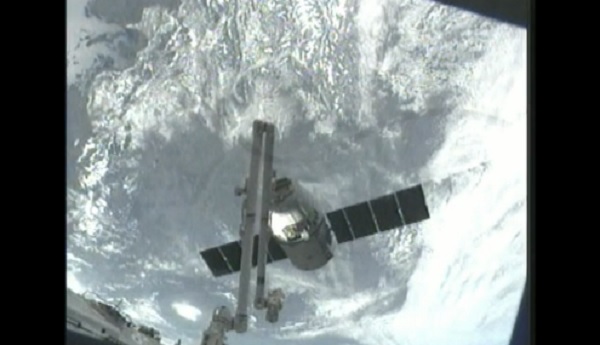
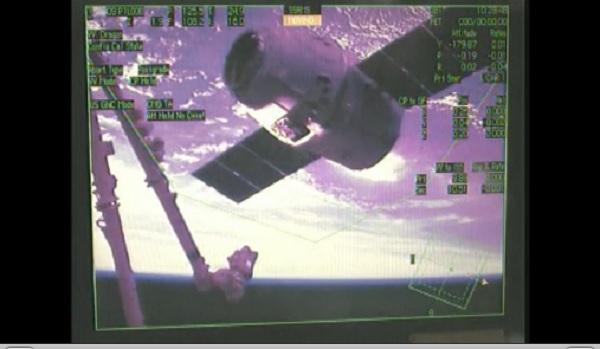
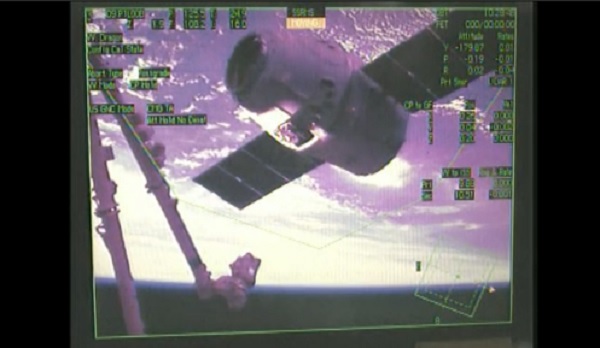
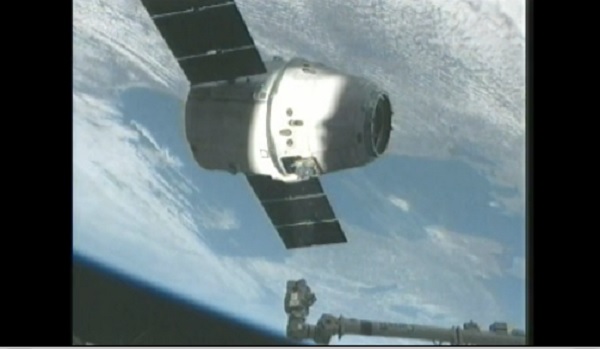
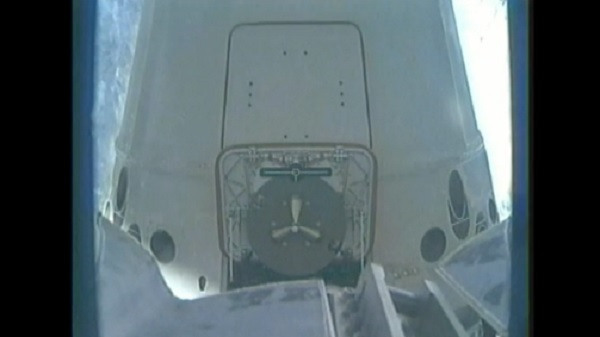
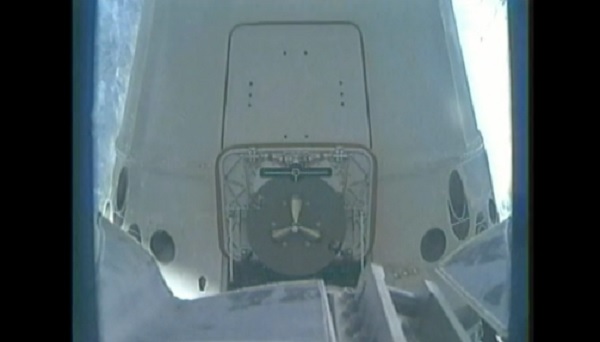 1
1
